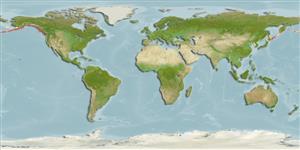>
Perciformes/Zoarcoidei (Eelpouts and pricklebacks) >
Stichaeidae (Pricklebacks) > Xiphisterinae
Etymology: Anoplarchus: Greek, ana = up + Greek, oplon = shield + Greek, archos = anus (Ref. 45335).
More on authors: Gilbert & Burke.
Environment: milieu / climate zone / depth range / distribution range
Ökologie
seewasser demersal; tiefenbereich 1 - 30 m (Ref. 2850). Temperate
Eastern Pacific: Aleutian Islands, Alaska to Arena Cove, Mendocino County, northern California, USA.
Size / Gewicht / Alter
Maturity: Lm ? range ? - ? cm
Max length : 12.0 cm TL Männchen/unbestimmt; (Ref. 2850)
Kurzbeschreibung
Bestimmungsschlüssel | Morphologie | Morphometrie
Rückenflossenstacheln (insgesamt) : 57 - 64; Rückenflossenweichstrahlen (insgesamt) : 0; Afterflossenstacheln: 0; Afterflossenweichstrahlen: 40 - 46; Wirbelzahl: 62 - 68. Dorsal well notched but joined to caudal; caudal rounded; pectorals bluntly pointed (Ref. 6885). Dark, or with a broken or variegated dark and light patterns usually with dark and light bars accentuating each other across jaw; frequently dark markings near anterior portion of dorsal fin and on the posterior margin of each gill cover; rarely individuals partly or completely bright red (Ref. 6885).
Facultative air-breathing (Ref. 126274); Prefers subtidal areas among rocks (Ref. 2850) and algae to depths of 30 meters (Ref. 51666).
Life cycle and mating behavior
Geschlechtsreife | Fortpflanzung | Ablaichen | Eier | Fecundity | Larven
Eschmeyer, W.N., E.S. Herald and H. Hammann, 1983. A field guide to Pacific coast fishes of North America. Boston (MA, USA): Houghton Mifflin Company. xii+336 p. (Ref. 2850)
IUCN Rote Liste Status (Ref. 130435: Version 2024-1)
Bedrohung für Menschen
Harmless
Nutzung durch Menschen
Fischereien: kommerziell; Aquarium: Öffentliche Aquarien
Tools
Can't connect to MySQL database fbquizv2. Errorcode: Too many connections
